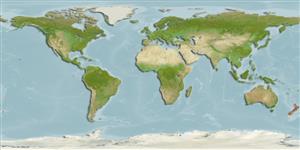Common names from other countries
Classification / Names / Names
Namen | Synonyme | Catalog of Fishes (gen., sp.) | ITIS | CoL | WoRMS
Environment: milieu / climate zone / depth range / distribution range
Ökologie
; tiefenbereich 0 - 5 m (Ref. 101364). Temperate, preferred 14°C (Ref. 107945); 34°S - 53°S, 68°E - 175°W
Southwest Pacific and Antarctic Indian Ocean: New Zealand, Chatham Island and Kerguelen. Temperate to polar.
Length at first maturity / Size / Gewicht / Alter
Maturity: Lm ?, range 2 - ? cm Max length : 4.9 cm SHL Männchen/unbestimmt; (Ref. 126738); max. veröff. Alter: 20 Jahre (Ref. 126742)
Estuarine species. Lives in near surface sediments (Ref. 121878), in intertidal sandflats (Ref. 101358) and sandy muddy mid-tidal areas (Ref. 101361). This is a suspension feeder (Refs. 101363, 121878).
Life cycle and mating behavior
Geschlechtsreife | Fortpflanzung | Ablaichen | Eier | Fecundity | Larven
Members of the class Bivalvia are mostly gonochoric, some are protandric hermaphrodites. Life cycle: Embryos develop into free-swimming trocophore larvae, succeeded by the bivalve veliger, resembling a miniature clam.
Spurgeon, A. 2007. (Ref. 8121)
IUCN Rote Liste Status (Ref. 130435)
CITES Status (Ref. 108899)
Not Evaluated
Not Evaluated
Nutzung durch Menschen
Fischereien: kommerziell
FAO - Fischereien: landings | FishSource | Sea Around Us
Tools
Internet Quellen
Estimates based on models
